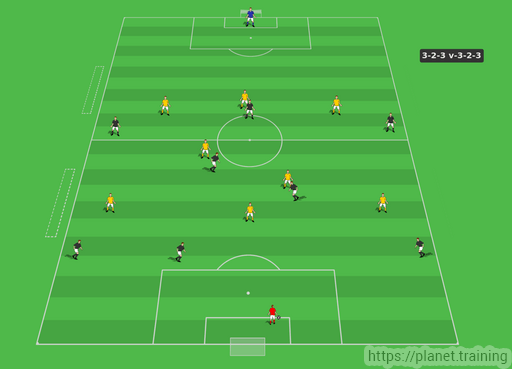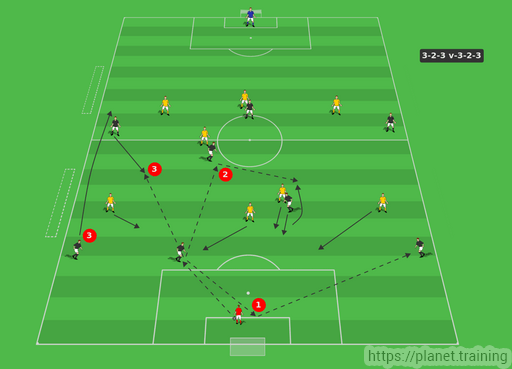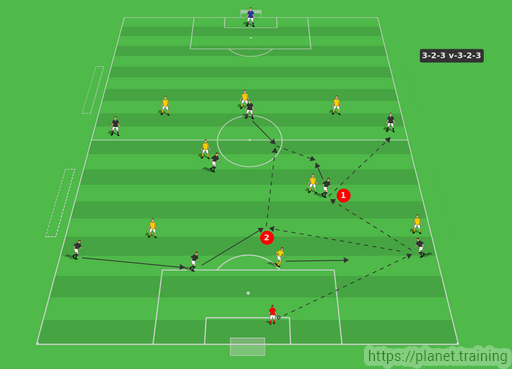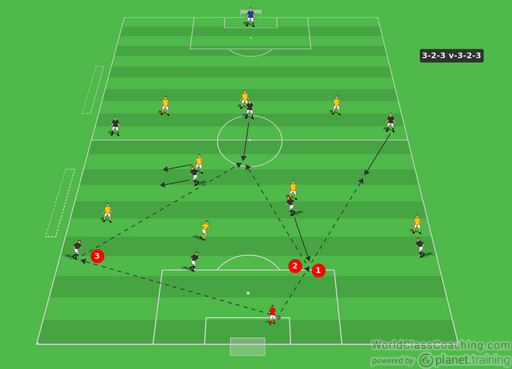By Sean Pearson
With the new USSF mandated birth year and small sided games changes there is a lot of trial and error regarding formations and systems of play. Instead of 8v8 formations, as coaches, we are now trying to figure out how to position our players in the new 7 v 7 and 9 v 9 formations. Some clubs have an academy structure where all teams must play the same formation, others allow coaches to choose what works for their team because players in each team have different attributes.
In these Systems of Play articles, I aim to address a wide range of 7 v 7, 9 v 9 and 11 v 11 formations and ways in which to use your players to your advantage.
Formation
The 3-2-3 formation is the US Soccer Federation’s recommended formation and is good for a playing out of the back style of play. With 3 players close to the goal keeper and a central midfielder that can drop down the formation gives plenty of options for the team to play out.

Options for Playing Out of the Back
The different options for your team to play out of the back all depend on how the opposition play, their formation and their style. The important thing is for your players to start in positions that enable your team to move the ball forward. As 3-2-3 is the USSF’s recommended formation I will look at the options you can use when facing this formation. You will be able to use some of the same options when facing other formations.
Each time there is a goal kick you back 3 should line up as below, the two full backs wide and on the touch line and the center back on one side of the goal. It doesn’t matter which side but the center midfielders must react to the center back’s positioning by having the deeper center midfielder on the opposite side from them. You want to create a diamond up the field with the center back, 2 center midfielders and the striker.
- Pass to the center back, if there is pressure the center back should pass back to the goalkeeper who quickly switches it to the opposite side full back. From there the full back can move forwards with the ball or pass into the midfield.
- When receiving the ball the center back has an open body shape. The deeper center midfielder drops down, bringing the player marking them with them. This creates the space to receive the ball later. The center midfielder, on the same side as the center back, stays as high as possible. When the center back passes in to the feet of this midfielder, this is the trigger for the deeper midfielder to spin behind the opposition player to receive the ball in the space they created.
- The wide striker stays high and wide and when the center back looks up they drop down and in field at the same time the full back overlaps the striker. If the opposition fullback doesn’t come then you have a 2v1 on the wing, if they do then you could either play back to the center back or a free center midfielder who could then pass the ball into the space for the advancing full back.

When playing to the opposite side:
- The full back can use the center midfielder to bounce the pass to the side striker.
- The center back can step forward into the space if the opposition striker aims to cut off the passing line between them and the full back. The opposite full back tucks in so the middle is not left open to the counter. The center back can then move the ball forward until challenged or play to the striker who starts high but then drops down to set the ball to the deeper midfielder, who again spins behind the opposition player marking them so they can’t see both the ball and them.

To keep the opposition guessing on how and where you will play out they are further options:
- The deeper center midfielder can drop into a position that a center back would be in when playing 4 at the back. When the pass arrives if there is instant pressure then the midfielder can set back to the goalkeeper and they can use another option. If there is no pressure they can receive on the half turn. The wide striker can drop down into the space. You could also have the fullback overlap like in an earlier option.
- The higher center midfielder must move away from their position, if they are being closely man marked, this creates space for the striker to drop in to.
- The same outcome for the striker can be attained if the fullback on the side of the center back receives the ball and again the midfielders move apart allowing the striker to drop into the space created to receive the ball. This can be effective if the center midfielders are always man marked and the opposition like to press and you can not get out of your half.

As you can see there are a lot of options for playing out the back with this system. It is important your players understand the reasons for each decision and why each option may be best in a different scenario. This will help develop their game understanding and intelligence as well as their technical components to the game.
By Sean Pearson. Sean is also the author Coaching Team Shape in the 3-3-1, Coaching Team Shape in the 4-2-3-1 and Coaching Team Shape in the 4-3-3


